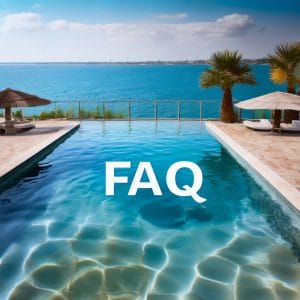
Please review our frequently asked questions. If there is something more specific that you are looking for, then please check the webpage for your model chlorinator, or contact us directly.
Salt water chlorination, uses dissolved salt (2,500–36,000 ppm) and a chlorine generator (also known as salt cell, salt generator, salt chlorinator) through electrolysis to break down the salt (NaCl). The resulting chemical reaction produces hypochlorous acid (HCIO), and sodium hypochlorite (NaClO), which are the sanitizing agents already commonly used in swimming pools. As such, a saltwater pool is not actually chlorine-free; it simply utilizes a chlorine generator instead of direct addition of chlorine.
This all depends on the time of year, the number of people swimming and the flow rate of your pump. Ideally, run for 4 hours in the morning (6am-10am) and 4 hours in the evening (4pm-8pm). For a smaller pool you can run less hours. In extreme weather it may be necessary to run longer hours. Contact your local pool Professional for further assistance.
Salt should always be added to the shallow end of the pool, in a newly filled pool, only run the pump in the first 8-12 hours (ensure the cell is switched off) to allow the salt to dissolve. Do not let the salt settle on the floor of the pool as this may cause damage to the surface. Use your pool brush to mix the salt into the water.
The Salt Chlorinator unit is designed for use with swimming pool water balanced in accordance with the Langelier Saturation Index with a pH range of 6.8-7.8. For best performance and operation of your Salt Chlorinator unit, certain water balances must be maintained within your swimming pool. Have your water tested regularly. Transport the test water in an opaque container and have the test done as soon as possible for best results.
Reverse Polarity cells should not normally require cleaning, however, in areas with very hard water all calcium may not be removed. A calcium deposit might form on the lower areas of the cell, the sensor, or the sides of the cell plates. This will affect the operation of your chlorinator; however, you can use Cell Cleaner to clean the Cell. All salt chlorinator cells must be cleaned before scale/calcium builds up to the point where the electrode gaps in the Cell are bridged. If the Cell has an excessive calcium deposit, this may damage the electrode coating, as the bridging causes a rubbing on the place coating, and this will affect the operation. Check the Cell regularly to prevent the accumulation of pool debris that for any reason may have by-passed the pool filter, particularly after backwashing.
Check that the O-ring is clean, greased with silicone grease (DO NOT use petroleum-based jelly) and securely located in the Cell Housing.
* Insufficient Salt Level in the water: Check the salt level. If the salt level is too low, the chlorinator will not be able to produce chlorine effectively. Make sure the salt concentration is within the recommended range specified in the user manual.
* Salt Cell Needs Cleaning: The salt cell may get clogged with debris or scale over time, hindering chlorine production. Clean the salt cell according to the manufacturer’s instructions regularly.
* Check the Chlorinator Power Supply: Ensure that the chlorinator is receiving the appropriate power supply. Verify that it is correctly connected to a power source and there are no issues with the power cable.
* Check the Water Flow Rate: The chlorinator requires proper water flow to generate chlorine. Verify that the water flow is sufficient and not restricted by any blockages in the plumbing or pump system.
* Inspect Cell for Faults: If the salt cell is damaged or faulty, it may not produce chlorine. Inspect the cell for signs of damage and consider replacing it if necessary.
* Test and Adjust pH Levels: High or low pH levels can impact chlorine production. Test and adjust the pH levels to ensure they are within the recommended range for the chlorinator to work optimally.
* Check for Error Codes: If your chlorinator has a display panel, check for any error codes or error messages that may provide insight into the issue.
* Review the User Manual: Refer to the user manual for specific troubleshooting steps related to your chlorinator model.
* If after going through these steps, the chlorinator is still not producing chlorine, it may be necessary to contact the manufacturer’s customer support or seek assistance from a professional pool equipment technician to diagnose and resolve the problem.
Review all our resources and how-to videos on our products
Learn more about our training services and how we can support you.
Register your product for warranty claims. This will expedite claims.